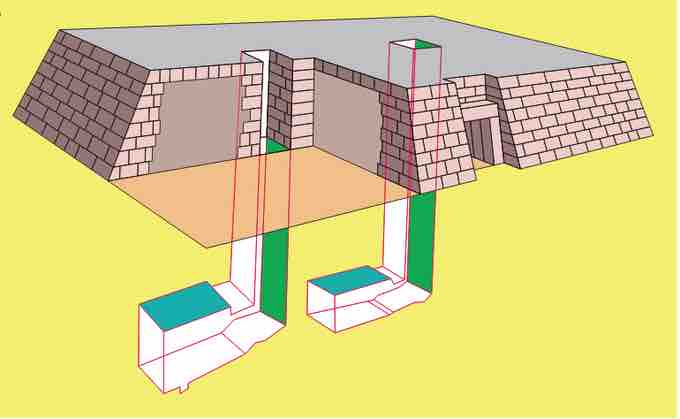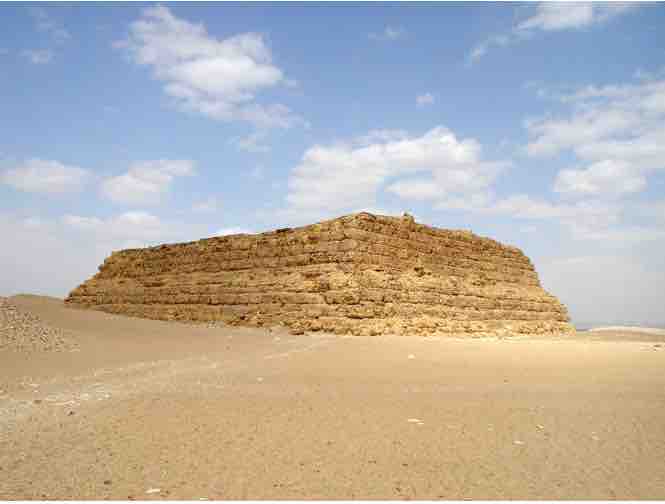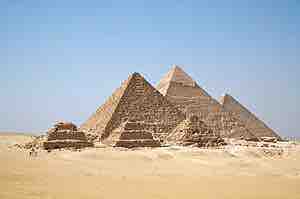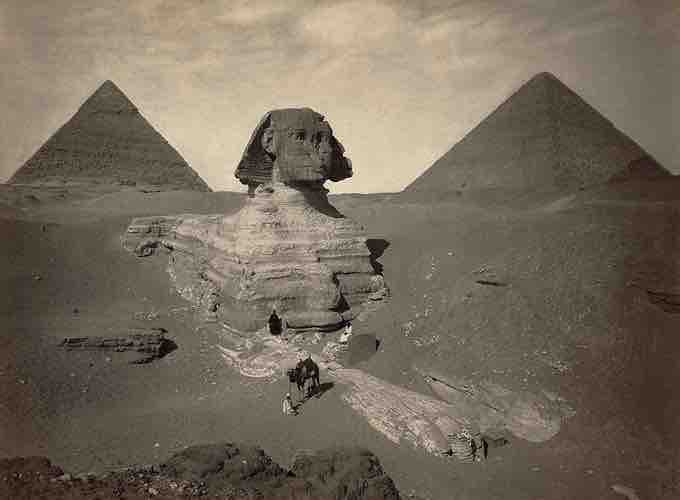The Old Kingdom of Egypt existed from the third through the sixth Dynasties (2686 BC–2182 BC). A period of political stability and economic prosperity, it is characterized by revolutionary advancements in royal funerary architecture. Both Egyptian society and the economy were greatly impacted by the organization of major state-sponsored building projects, which focused on building tombs for their kings. These tombs were built in the form of great pyramids, and for this reason, the Old Kingdom is frequently referred to as the "Age of the Pyramids."
Evolution of the Mastaba
During the Old Kingdom, royal mastabas eventually developed into rock-cut "step pyramids" and then "true pyramids," although non-royal use of mastabas continued to be used for more than a thousand years. As the pyramids were constructed for the kings, mastabas for lesser royals were constructed around them. The interior walls of the tombs were decorated with scenes of daily life and funerary rituals. Because of the riches included in graves, tombs were a tempting site for grave-robbers. The increasing size of the pyramids is in part credited to protecting the valuables within, and many other tombs were built into rock cliffs in an attempt to thwart grave robbers.

Mastaba schematic
Inside the mastaba, a deep chamber was dug into the ground and lined with stone or bricks. Over time these tomb chambers sank more deeply and were connected by stairs. The above-ground structure had space for a small chapel to which priests and family members could bring offerings for the soul of the deceased.

Example of a Mastaba
Royal mastabas were used to mark burial sites of many important Egyptians.
Djoser's "Step Pyramid"
The first king to launch a major pyramid building project was King Djoser, who ruled in the 3rd Dynasty. He built his famous "Step Pyramid" at Saqqara, not far from the capital city of Memphis (near modern-day Cairo). In the following dynasties, the pyramid design changed from the "step" pyramid to a true pyramid shape as kings continued to build tombs for their kings. Among these, the Pyramids of Giza are considered the greatest architectural achievement of the time.

Step Pyramid at Saqqara
Djoser's step pyramid was the first of the great pyramids built during the Old Kingdom in Eqypt. Unlike later pyramids, it used a step design that is easily recognized.
The Pyramids of Giza
The Pyramids of Giza, also known as the Giza Necropolis, are one of the oldest remaining wonders of the world. The Necropolis includes three pyramid complexes: the Great Pyramid (built by King Khufu of the 4th Dynasty); the somewhat smaller Pyramid of Khafre (buit by Khufu's son); and the relatively modest-sized Pyramid of Menkaure.

The Pyramids of Giza
This view shows all three pyramid structures: the Great Pyramid, the Pyramid of Khafre, and the Pyramid of Menkaure.
The Necropolis also includes several cemeteries, a workers' village, an industrial complex, and a massive sculpture known as the Great Sphinx. The Great Sphinx is a limestone statue of a reclining sphinx—a mythical creature with a lion's body and a human head. It is commonly believed that the head is that of King Khafra, who ruled during the 4th dynasty. It is the largest monolith statue in the world, standing 241 ft long, 63 ft wide, and 66.34 ft high.

Albumen print of the Sphinx of Giza, partially excavated, with two pyramids in background
The Great Sphinx of Giza is the largest monolith statue in the world and was believed to have been built for King Khafra during the 4th Dynasty.
We still do not know exactly how the huge and impressive stone monuments were built. Most of the stone for the interior seems to have been quarried immediately to the south of the construction site. The smooth exterior of the pyramid, however, was made of a fine grade of white limestone that was quarried from the other side of the Nile River. These exterior blocks had to be carefully cut, transported by river barge to Giza, and dragged up ramps to the construction site. Theorists disagree as to the method by which the stones were then put into place and how possible the method was. It's also possible that the architects developed their techniques over time.
The sides of all three of the Giza pyramids were astronomically oriented to the north-south and east-west within a small fraction of a degree. To ensure that the pyramid remained symmetrical, the exterior casing stones all had to be equal in height and width. Workers might have marked all the blocks to indicate the angle of the pyramid wall and trimmed the surfaces carefully so that the blocks fit together.
The work of quarrying, moving, setting, and sculpting the huge amount of stone used to build the pyramids might have been accomplished by several thousand skilled workers and unskilled laborers. Evidence from the tombs indicates that a workforce of 10,000 laborers working in three-month shifts took around 30 years to build a single pyramid.
Mummification and Burial Ritual
In order to preserve the body and, therefore, the soul of the deceased, Egyptians used the process of mummification. This involved removing the internal organs, wrapping the body in linen, and burying the mummy in a rectangular stone sarcophagus or wooden coffin. Because it was believed that the deceased would continue his or her earthly life in the afterlife, accommodations were made to ensure this transition. The Opening of the Mouth Ceremony was a ritual involving the symbolic animation of a mummy by magically opening its mouth so that it could breathe, speak, eat, and drink in the afterlife.
Many mummies were provided with some form of funerary literature, often consisting of spells and instructions for navigating the afterlife. During the Old Kingdom, only the pharaoh had access to this material, which scholars refer to as the Pyramid Texts. The Pyramid Texts are a collection of spells to assure the royal resurrection and protect the pharaoh from various malignant influences.